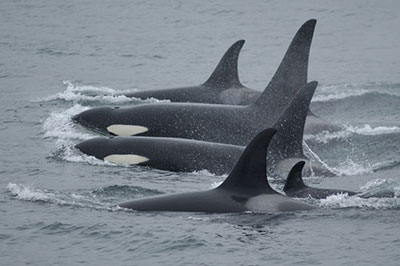Who Started The Study Of Aquatic Animal Communication
Many marine animals rely on sound for survival and depend on unique adaptations that enable them to communicate, protect themselves, locate food, navigate underwater, and/or understand their environment. They may both produce sounds and listen to the sounds around them.
Sounds are particularly useful for communication because they can exist used to convey a neat bargain of information chop-chop and over long distances. Changes in rate, pitch, and/or structure of sounds communicate different messages. In particular, fishes and marine mammals utilize audio for communications associated with reproduction and territoriality. Some marine mammals likewise use audio for the maintenance of grouping construction.

Dolphins, such every bit these common dolphins (Delphinus spp.), travel in large groups, therefore, sound is important for communication to maintain group structure. Photo courtesy of NOAA/NEFSC.
Like to sonar systems on ships, some whales use sound to notice, localize, and characterize objects. By emitting clicks, or short pulses of sound, these marine mammals can listen for echoes and detect objects underwater. This is calledecholocation. Some whales and dolphins use echolocation to locate food. They send out pulsed sounds that are reflected back when they strike a target. The assay of the echoes helps the animals determine the size and shape of an object, its location, whether information technology is moving, and how far away it is. Echolocation is an effective way to locate casualty and too helps whales and dolphins analyze their environment.

Toothed whales, such as these orcas, utilize sound to locate prey. Photo courtesy of NOAA/NMFS.
Many species of fish and aquatic invertebrates too use sound. Fishes produce various sounds, including grunts, croaks, clicks, and snaps, that are used to attract mates equally well as ward off predators.

Big eye scad, a tropical fish, produce sounds using their pharyngeal teeth. These sounds are oft heard when a fish is captured and may function to ward off predators. Photo courtesy of John E. Randall.
The life history of many coral reef fishes includes a pelagic larval phase that metamorphoses to the juvenile stage. Tardily stage larvae and transforming juveniles need to reach suitable reef habitats to mature. There is some evidence that underwater reef sounds may be detected past coral reef fish (and invertebrate) larvae guiding them to littoral areas and allowing them to identify suitable settlement habitats [1] Simpson, S., Meekan, Yard., McCauley, R. and Jeffs, A. (2004) Attraction of Settlement-Stage Coral Reef Fishes to Reef Dissonance. Marine Ecology Progress Serial, 276, 263–268. https://doi.org/10.3354/meps276263. [2] Isle of mann, D., Casper, B., Boyle, K. and Tricas, T. (2007) On the Attraction of Larval Fishes to Reef Sounds. Marine Ecology Progress Series, 338, 307–310. https://doi.org/x.3354/meps338307. [iii] Vermeij, G.J.A., Marhaver, G.L., Huijbers, C.M., Nagelkerken, I. and Simpson, South.D. (2010) Coral Larvae Move toward Reef Sounds. Vollmer, S., Ed., PLoS ONE, 5, e10660. https://doi.org/10.1371/periodical.pone.0010660. [four] Simpson, S.D., Meekan, M.G., Larsen, North.J., McCauley, R.D. and Jeffs, A. (2010) Behavioral Plasticity in Larval Reef Fish: Orientation Is Influenced by Contempo Acoustic Experiences. Behavioral Ecology, 21, 1098–1105. https://doi.org/10.1093/beheco/arq117. [5] Kennedy, Eastward.V., Holderied, M.W., Mair, J.M., Guzman, H.M. and Simpson, S.D. (2010) Spatial Patterns in Reef-Generated Noise Chronicle to Habitats and Communities: Prove from a Panamanian Instance Study. Journal of Experimental Marine Biology and Environmental, 395, 85–92. https://doi.org/10.1016/j.jembe.2010.08.017. . Different coastal habitat types take been establish to produce different ambient sounds over short distances.

The larvae of some coral reef fish species like these damselfish, may utilise sound to locate suitable settlement areas. Image credit: NOAA.
Little enquiry has been washed on marine invertebrates that produce sounds. However, several marine invertebrates, including spiny lobsters and fiddler crabs, have been institute to produce sounds for defensive and courtship purposes. Some marine invertebrates use audio for other purposes. The cleaner shrimp announces itself as a cleaner and advertises its services by clapping 1 pair of its claws when reef fish approach.
Cleaner shrimps identify themselves as a "cleaner" and annunciate their services to reef fish by clapping their claws (chelipeds). The hungrier the shrimp, the more than clapping it does. In this video, i can watch a cleaner shrimp (small, transparent fauna at eye) clap/indicate to reef fish swimming nearby.
Video by Lucille Chapuis, Academy of Western Australia
Additional Links on DOSITS
- Bigeye Scad
- Common Dolphin
- How practise people and animals use sound in the sea?
- How do fish hear?
- How do fish produce sounds?
- How practise marine mammals hear?
- How exercise marine mammals produce sounds?
- Killer Whale
- Marine fish communication
- Marine invertebrate communication
- Marine mammal advice
- Marine mammal navigation
- Marine mammals feeding
- Spiny Lobster
References
- Radford, C. A., Stanley, J. A., Simpson, S. D., & Jeffs, A. M. (2011). Juvenile coral reef fish use sound to locate habitats. Coral Reefs, thirty(2), 295–305. https://doi.org/10.1007/s00338-010-0710-6
- Radford, C., Stanley, J., Tindle, C., Montgomery, J., & Jeffs, A. (2010). Localised coastal habitats have singled-out underwater audio signatures. Marine Ecology Progress Series, 401, 21–29. https://doi.org/10.3354/meps08451
- Simpson, S. D., Meekan, M. G., Jeffs, A., Montgomery, J. C., & McCauley, R. D. (2008). Settlement-phase coral reef fish prefer the college-frequency invertebrate-generated audible component of reef racket. Animal Behaviour, 75(half-dozen), 1861–1868. https://doi.org/10.1016/j.anbehav.2007.11.004
- Simpson, Southward. D., Radford, A. Due north., Tickle, E. J., Meekan, M. Yard., & Jeffs, A. G. (2011). Adaptive avoidance of reef noise. PLoS One, 6(2), e16625. https://doi.org/x.1371/journal.pone.0016625
Source: https://dosits.org/animals/use-of-sound/how-do-marine-animals-use-sound/
Posted by: mirandalacceir.blogspot.com

0 Response to "Who Started The Study Of Aquatic Animal Communication"
Post a Comment